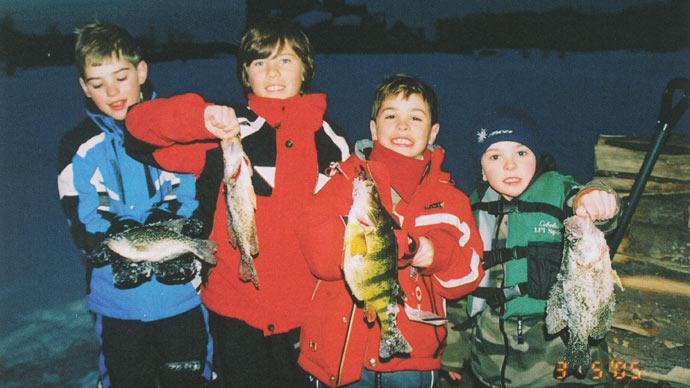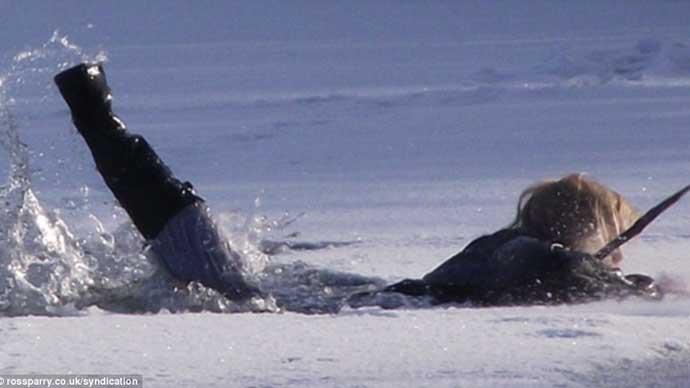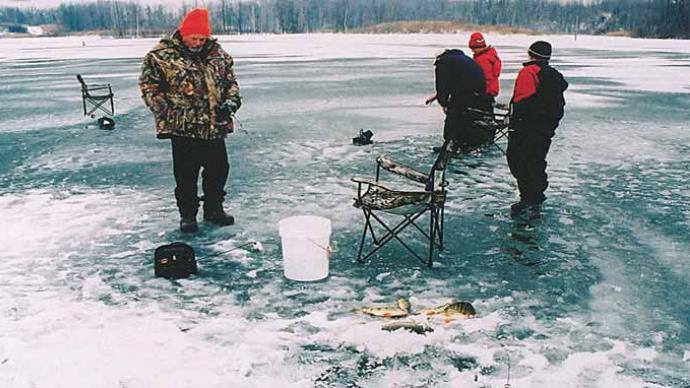
Here's to those souls who live in North America's ice belt. Winter starts early and stays late. We face as much as 5 months of ice cover on many northern ponds. Too many people look over their private waters and see a useless, frozen pond or silent lake collecting snow. It doesn't need to be that way. Ice fishing is a great way to spend cold winter months pursuing lunkers missed last summer. Whether your pond is full of panfish. bass, walleye or trout, these fish are great fun angled through ice.
This article is designed to entice you to get out and try ice fishing to cure winter blues.
First things, first. We need to talk about ice and ice safety. When checking ice, always be accompanied by someone that can help, or seek help, should you break through. Safe ice is at least 4 inches thick, but always have someone with you when ice fishing. No exceptions. If you have natural springs, inlets or outlets in your lake, ice can be significantly thinner near those places. Avoid these areas. There are other situations which lends to thin ice. Downed timber, hummocks, and emergent vegetation lessen structural integrity of ice. The best way to check thickness of ice is to simply walk out, close to shore, and drill a hole using your auger. Be aware, not all ice is the same. Water freezes, but the consistency of your ice may be determined by environmental factors such as snow, or slush and associated air temperatures. When a lake first freezes, ice may only be an inch thick. Add snow to that ice layer, then a crusty coat of freezing rain, then snow.. ..your ice may be different as winter sets in. Learn the ice, its integrity and thickness. Once you are comfortable and the ice is thick, plan to go fishing.
Many ice fishermen drag a plastic sled behind them, onto the ice. Not only does the sled carry all fishing equipment, it should also contain safety equipment. Hand-held spikes, like golf cleats at the end of a bicycle grip, can be used, in case you fall through. Plus, the sled may be able to help stabilize in some situations.
The first piece of ice fishing equipment to purchase is an auger. Some ice fishermen are known to drill many holes before finding the "perfect" one to fish. There are several options. The least expensive and easiest way to start is a 6" hand auger. Augers come in different sizes. You can drill: 4", 6", 8" and 10" holes. Keep in mind, the larger the hole the harder to drill. As you become more involved in ice fishing it may be more advantageous to purchase a power auger. A gas powered auger can range in price from $250 to $600.
In recent years, ice fishing has gained passionate popularity due to the fact it can be a very effective way of catching fish during otherwise difficult fishing months. Part of that passion is because of availability of some interesting technology gadgets. Hand held depth finders, fish locators, cameras on the end of a cable...real world star trek stuff fishermen can use to find fish under the ice. Getting the cold blooded creatures to bite is another story. Technology and equipment allows anglers to put a lot of fish on the ice.
Popular ways of catching fish are by using a short jigging rod that looks like a tiny spinning rig. Or, use tip-ups. Tip-ups require use of live bait on tiny hooks at the end of the line. When a fish bites, it will trigger a flag to pop up. At this point you know that a fish has taken your bait. Plus, with tip-ups, one fisherman can fish several different holes at the same time.
When jigging for fish through the ice you should try to match gear with the size fish you are targeting. Panfish require a smaller jig matched with an ultra light action rod and reel combo, compared to walleye or pike fishing which requires heavier tackle. When fishing for panfish tipping your jig with different types of worms and grubs will increase your catch. Walleye and pike prefer a minnow on the jig. Going to your local tackle shop, here in the north, these pros should be able to help you decide what jigs and tackle will provide the most success.
To make ice fishing as comfortable as possible there are a couple other gear investments to make. When temperatures are low it's wise to own a good pair of insulated waterproof boots to keep your feet warm. Dressing in layers is a good idea because you can always take layers off but it is hard to put them on when you are out on the ice. On larger bodies of water, howling winds can play a big role in how long you can comfortably stay on the ice. If you really want to stay out all day in frigid winter conditions, a portable ice shanty is an excellent choice. Build one yourself or go to local tackle shops and purchase a portable canvas ice shelter that can comfortably fish as many as six people. Inside these shanties you can use a small propane heater to stay warm and comfortable all day.
If you find yourself getting really serious about ice fishing and want to seriously enhance fish catching capabilities, there are two fish finder units which play a major role in the ice fishing world. The first is an under water camera powered by a small 12 volt rechargeable battery which lasts all day. These cameras allow you to literally watch your jig on a TV screen and find out how fish react to it. Cameras are especially intriguing because they bring a different dimension to the entire fishing experience. Even though some of the mystery of fishing is lost, it's quite a pleasure to try to trick a fish you see on a video screen. The second unit is an acoustic flasher that also runs on a 12 volt battery. This unit acts just like a Lowrance fish finder found on many a bass boat. It works on a three-color LED flashing light. The company that has really cornered the market is the Vexilar ® Company. These units cost $250 to $500, with a two-year warranty.
Major species of fish targeted in the northeast are yellow perch, crappie, sunfish, walleye, and northern pike. The reason these fish are major targeted species is they readily bite during winter months. Under ice, fish are faced with adverse conditions and food can become scarce, making them easier to catch because of hunger. Yellow perch, crappie. and sunfish can be caught on ultra-light tackle using 2-4 lb. test line in most any small pond. Walleye and northern pike are sought either jigging with heavier gear using 6-8 lb.test, or by using tip-ups.
This information should be useful getting started for wintry ice fishing adventures. You will find there are many different tips and tactics used in different parts of the country for different species. You may find one jig works for one situation whereas another jig or presentation works better in another situation. Ice fishing is a great way to get out in the wintertime to spend time with friends and family.
Have fun, be safe on the ice.
Reprinted with permission from Pond Boss Magazine




